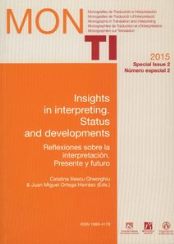The influence of healthcare professionals on medical interpreting recognition and development
Main Article Content
Abstract
Downloads
Article Details
The documents contained in these directories are included by the contributing authors as a means to ensure timely dissemination of scholarly and technical work on a non-commercial basis. It is understood that all persons copying this information will adhere to the terms and constraints invoked by each author's copyright. These works may not be reposted without the explicit permission of the copyright holder.
References
Angelelli, Claudia V. (2007) “Assessing Medical Interpreters: The Language and Interpreting Testing Project.” The Translator 13:1, pp. 63-82.
Angelelli, Claudia V. (2008) “The role of the interpreter in the healthcare setting. A plea for a dialogue between research and practice.” En: ValeroGarcés, Carmen & Anne Martin (eds.) 2008. Crossing Borders in Community Interpreting. Definitions and Dilemmas. Amsterdam & Filadelfia: John Benjamins, pp. 147-163.
Bischoff, Alexander & Patricia Hudelson. (2010a) “Access to Healthcare Interpreter Services: Where Are We and Where Do We Need to Go?” International Journal of Environmental Research and Public Health 7, pp. 2838-2844. Electronic version: http://www.ncbi.nlm.nih.gov/pmc/articles/PMC2922730/
Bischoff, Alexander & Patricia Hudelson. (2010b) “Communicating With Foreign Language–Speaking Patients: Is Access to Professional Interpreters Enough?” Journal of Travel Medicine 17:1, pp. 15-20. Electronic version: http://onlinelibrary.wiley.com/doi/10.1111/j.1708-8305.2009.00314.x/pdf
Bischoff, Alexander; Louis Loutan & Sofía García. (2009) En otras palabras. Guía para la consulta médica intercultural. Comunicación a través de un intérprete en los servicios de salud. Electronic version: http://www.universaldoctor.com/EnOtrasPalabras/
Brisett, Camille; Yvan Leanza & Karine Laforest. (2013) “Working with interpreters in health care: A systematic review and meta-ethnography of qualitative studies.” Patient Education and Counseling 91:2, pp. 131-140.
Corsellis, Ann. (2009) Public Service Interpreting: The First Steps. Basingstoke: Palgrave MacMillan. Citado por la traducción española de Carmen ValeroGarcés & Rosa Cobas: Traducción e interpretación en los servicios públicos. Primeros pasos. Granada: Comares, 2010.
Del Pozo, María Isabel. (2009) “Una propuesta formativa en interpretación en los servicios públicos en el marco del EEES.” Redit 3, pp. 31-51.
Diamond, Lisa C.; Yael Schenker; Leslie Curry; Elizabeth H. Bradley & Alicia Fernández. (2009) “Getting by: underuse of interpreters by resident physicians.” Journal of General Internal Medicine 24:2, pp. 256-262. Electronic version: http://www.ncbi.nlm.nih.gov/pmc/articles/PMC2628994/pdf/11606_
_Article_875.pdf
Flores, Glenn. (2005) “The impact of medical interpreter services on the quality of health care: a systematic review.” Medical Care Research and Review 62:3, pp. 255-299.
Flores, Glenn; Milagros Abreu; Cara Pizzo Barone; Richard Bachou & Hua Lin. (2012) “Errors of Medical Interpretation and Their Potential Clinical Consequences: A Comparison of Professional Versus Ad Hoc Versus No Interpreters.” Annals of Emergency Medicine 60:5, pp. 545-553.
Hale, Sandra Beatriz. (2007) Community Interpreting. Basingstoke: Palgrave MacMillan. Citado por la traducción española de Rosa Cobas y Carmen Valero-Garcés. La interpretación comunitaria. La interpretación en los sectores jurídico, sanitario y social. Granada: Comares, 2010.
Leanza, Yvan. (2005) “Roles of community interpreters in paediatrics as seen by interpreters, physicians and researchers.” Interpreting, Special Issue: Healthcare Interaction: Discourse and Interaction 7:2, pp. 167-192.
Leanza, Yvan. (2007) “Roles of community interpreters in pediatrics, as seen by, physicians and researchers.” En: Pöchhacker, Franz & Miriam Shlesinger (eds.) 2007. Healthcare interpreting. Amsterdam: John Benjamins, pp. 11-34.
Mikkelson, Holly. (1999) “Interpreting is Interpreting – Or is It?” Originally presented at the GSTI 30th Anniversary Conference, January 1999, Monterey, California. Electronic version: http://www.acebo.com/papers/INTERP1.HTM
Mikkelson, Holly. (2003) “Telephone Interpreting: Boon or Bane?” En: Pérez, Luis (ed.) 2003. Speaking in Tongues: Language across Contexts and Users. Valencia: Universitat de València, pp. 251-269.
Nápoles, Anna M.; Jasmine Santoyo-Olsson; Leah S. Karliner; Helen O’Brien; Steven E. Gregorich & Eliseo J. Pérez-Stable. (2010) “Clinician Ratings of Interpreter Mediated Visits in Underserved Primary Care Settings with Ad hoc, In-person Professional, and Video Conferencing Modes.” Journal of Health Care for the Poor and Underserved 21:1, pp. 301-317. Electronic version: http://www.ncbi.nlm.nih.gov/pmc/articles/PMC3576468/pdf/nihms434480.
Ozolins, Uldis. (2010) “Factors that determine the provision of Public Service Interpreting: comparative perspectives on government motivation and language service implementation.” JoSTrans. The Journal of Specialized Translation 14, pp. 194-215. Electronic version: http://www.jostrans.org/issue14/art_ozolins.pdf
Phelan, Mary & Mayte C. Martín. (2010) “Interpreters and cultural mediators – different but complementary roles.” Translocations 6:1, pp. 4-20.
Phelan, Mary & Sue Parkman. (1995) “How To Do It. Work with an interpreter.” BMJ 311, pp.555-557.
Pöchhacker, Franz. (2004) Introducing Interpreting Studies. Londres: Routledge.
Valero-Garcés, Carmen & Anne Martin (eds.) (2008) Crossing Borders in Community Interpreting. Definitions and Dilemmas. Amsterdam & Filadelfia: John Benjamins.
Valero-Garcés, Carmen. (2013) “Comunicación con población extranjera en el ámbito sanitario. Iniciación a una base de datos sobre artículos de investigación.” Panacea 37, pp. 80-86. Electronic version: http://www.medtrad.org/panacea/IndiceGeneral.htm#Vol14N37
Wadensjö, Cecilia. (1998) Interpreting as interaction. New York: Addison Wesley Longman Inc.
Wadensjö, Cecilia. (1999) “Telephone Interpreting and the Synchronization of Talk in Social Interaction.” The Translator 5:2, pp. 247-264.


